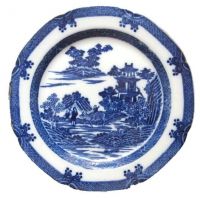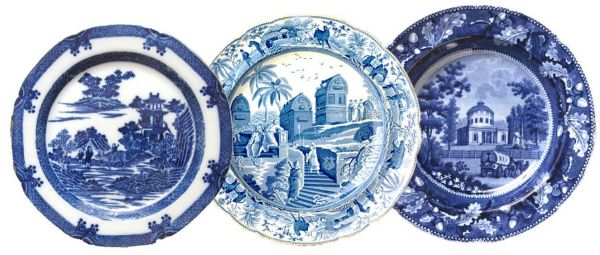Early blue printed designs
 When Josiah Spode introduced blue printing on earthenware in about 1784[i], the cobalt-blue oil used in the process was a dark inky blue and the designs were formed mostly from simple engraved lines. The earliest patterns were in the Chinese-taste and are known as chinoiserie designs. These scenes have their own charm, the coarsely engraved inky-blue designs are engraved with Asian "vertical perspective" in which near, middle, and far distance are seen in the lower, middle, and upper parts of the design respectively.
When Josiah Spode introduced blue printing on earthenware in about 1784[i], the cobalt-blue oil used in the process was a dark inky blue and the designs were formed mostly from simple engraved lines. The earliest patterns were in the Chinese-taste and are known as chinoiserie designs. These scenes have their own charm, the coarsely engraved inky-blue designs are engraved with Asian "vertical perspective" in which near, middle, and far distance are seen in the lower, middle, and upper parts of the design respectively.
 By the early years of the 19th century, the patterns were produced by using more sophicticated engraving techniques and color had been refined to a rich royal blue. The introduction of stipple engraving allowed engravers to create more sophisticated patterns. By grouping stippled dots more or less closely together – more and closer produced a stronger darker effect, fewer dots further apart produced a lighter effect - the engraver created tonal qualities of light and shade which made it possible to reproduce landscapes, portraits, and other scenes that met the western notion of perspective. And from this time engravers for the pottery industry often used prints on paper as a source of inspiration.
By the early years of the 19th century, the patterns were produced by using more sophicticated engraving techniques and color had been refined to a rich royal blue. The introduction of stipple engraving allowed engravers to create more sophisticated patterns. By grouping stippled dots more or less closely together – more and closer produced a stronger darker effect, fewer dots further apart produced a lighter effect - the engraver created tonal qualities of light and shade which made it possible to reproduce landscapes, portraits, and other scenes that met the western notion of perspective. And from this time engravers for the pottery industry often used prints on paper as a source of inspiration.

From the early years of the 19th century the most popular prints were in a bright azure blue, available in a wide variety of populist patterns. By about 1820, a richer, darker blue had been introduced, and although it never replaced the “royal” color, it was produced by a small number of manufacturers for about 10 or 15 years. It is apparent from retailers’ order books and archaeological excavations that the darker blue wares enjoyed a brief and intense popularity from about 1820 to 1830. Although made specifically for the American market, most of the patterns continued to be general in nature, but there was a small group of dark blue designs that became perhaps the most desirable of all collectable printed pottery – patterns illustrating the new nation of the United States.
Most of late 18th century under-glaze blue printed patterns onearthenware were typically chinoiseries popular in England, and only two designs are known to have been created especialy to appeal to an American market, both celebrate George Washington.
|



